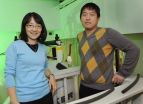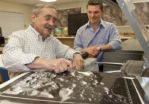Dad's weight and diet linked to offspring's risk of diabetes
Paternal weight plays important role in 'programming' diabetes in offspring through epigenetic changes
2010-10-22
(Press-News.org) Medical researchers at the University of New South Wales have for the first time shown a link between a father's weight and diet at the time of conception and an increased risk of diabetes in their offspring.
The finding, reported in the prestigious journal Nature, is the first in any species to show that paternal exposure to a high-fat diet initiates progression to metabolic disease in the next generation.
"We've known for a while that overweight mums are more likely to have chubby babies, and that a woman's weight before and during pregnancy can play a role in future disease in her children, partly due to the critical role the intrauterine environment plays in development," said study leader Professor Margaret Morris, from UNSW's School of Medical Sciences.
"But until now, the impact of the father's environment – in terms of his diet – on his offspring had not been investigated."
The work formed the basis of the PhD study of Dr Sheau-Fang Ng, who showed that paternal environmental factors such as diet and weight are important contributors to disease in the next generation
In the Nature study, male rats were fed a high fat diet to induce obesity and glucose intolerance and then mated with normal weight females. The resulting female offspring exhibited impaired glucose tolerance and insulin secretion as young adults.
"This is the first report of non-genetic, intergenerational transmission of metabolic consequences of a high fat diet from father to offspring," Professor Morris said. "A family history of diabetes is one of the strongest risk factors for the disease; however until now, the extent of any influence of non-genetic paternal factors has been unclear."
Professor Morris said the research showed that overweight fathers can play a role in "programming" epigenetic changes in their offspring, possibly through effects on their sperm caused by their consumption of high-fat food. Epigenetics is a process whereby changes in gene expression – and hence function – can occur even when there are no alterations in the DNA sequence.
Professor Morris said the study expands our understanding of the role environmental factors might play on a child's physiology and metabolism.
"It adds another level to our understanding of the causes of the growing epidemics in obesity and diabetes," she said. "While here we studied female offspring, we need to examine whether the effect is also found in males".
INFORMATION:
The work was performed in collaboration with scientists in the UNSW Schools of Medical Sciences and Biotechnology and Biomolecular Sciences, the Garvan Institute, and the University of Adelaide.
Professor Morris will present the findings at the Australia and New Zealand Obesity Society meeting, Friday 22 October, at the Hilton Hotel Sydney.
END
ELSE PRESS RELEASES FROM THIS DATE:
2010-10-22
An international CSIRO-led team of astronomers has developed a new way to weigh the planets in our Solar System – using radio signals from the small spinning stars called pulsars."This is first time anyone has weighed entire planetary systems – planets with their moons and rings," said team leader Dr David Champion from Germany's Max-Planck-Institut für Radioastronomie.
"And we've provided an independent check on previous results, which is great for planetary science."
Measurements of planet masses made this new way could feed into data needed for future space missions.
Until ...
2010-10-22
WASHINGTON, D.C., (Oct. 21, 2010) -- Over the past decade, Christine Mahoney and a team of scientists at the National Institute of Standards and Technology (NIST) in Maryland have been working to stop the threat of terrorist-based attacks in the form of explosives or explosive-based devices, by providing a sound measurement and standard infrastructure.
"Our program encompasses many different aspects of explosives research, from development of measurement standards for trace explosives detection at airports, to the development and application of new metrology for the direct ...
2010-10-22
Measuring three biomarkers in a single blood sample may improve physicians' ability to identify patients at high risk of developing chronic kidney disease (CKD), according to a study appearing in an upcoming issue of the Journal of the American Society of Nephrology.
"Our results identify biomarkers that can improve CKD risk prediction," comments Caroline S. Fox, MD, MPH of the National Heart, Lung, and Blood Institute's Framingham Heart Study, Framingham, Mass.
The study included more than 2,300 participants in the Framingham Offspring Study, a long-term follow-up ...
2010-10-22
NASA's Lunar Reconnaissance Orbiter (LRO) and its sophisticated suite of instruments have determined that hydrogen, mercury and other volatile substances are present in permanently shaded soils on the Moon, according to a paper published today in Science.
The Lunar Crater Remote Observation and Sensing Satellite (LCROSS), which launched with LRO, was intentionally crashed onto the Moon's surface Oct. 9, 2009, while LRO instruments watched. About 90 seconds after LCROSS hit the Moon, LRO flew past the debris plume raised by the impact, while the Lyman Alpha Mapping Project ...
2010-10-22
AMES, Iowa – The flu virus uses a shuttle mechanism to relay protons through a channel in a process necessary for the virus to infect a host cell, according to a research project led by Mei Hong of Iowa State University and the Ames Laboratory.
The findings are published in the Oct. 22 issue of the journal Science.
Hong, an Iowa State professor of chemistry and an associate of the U.S. Department of Energy's Ames Laboratory, said her research team used solid-state nuclear magnetic resonance (NMR) spectroscopy to determine the structure and workings of the proton channel ...
2010-10-22
Beating the flu is already tough, but it has become even harder in recent years – the influenza A virus has mutated so that two antiviral drugs don't slow it down anymore.
Reporting their findings in the journal Science, researchers from Florida State and Brigham Young move closer to understanding why not, and how future treatments can defeat the nasty bug no matter how it changes.
The two drugs, amantadine and rimantadine, are no longer recommended by the CDC for use against flu.
They used to work by blocking a hole in the influenza A virus called the "M2 channel," ...
2010-10-22
(Embargoed) Scientists at the University of North Carolina at Chapel Hill School of Medicine have reported the exact molecular structure and mechanisms of a major cell signaling pathway that serves a broad range of functions in humans.
Up to half of drugs approved by the US Food and Drug Administration directly or indirectly target G protein-coupled receptors. These receptors, which are proteins that live in the outer membranes of cells, take molecular signals from outside the cell and convert them into responses within – and those responses help control behaviors as ...
2010-10-22
Research led by Klaus Stark and Christian Hengstenberg of the University of Regensburg identified a common variant of the cardiovascular heat shock protein gene, HSPB7, which was found to increase risk for dilated cardiomyopathy by almost 50%. Their paper appears on October 28 in the open-access journal PLoS Genetics.
Per year, about 6 in 100,000 individuals develop dilated cardiomyopathy (DCM), with a higher prevalence in men. This disease is characterized by an enlarged, weakened heart, subsequently affecting the pumping capacity and often leading to chronic heart failure. ...
2010-10-22
CAMBRIDGE, Mass. -- Most marathon runners know they need to consume carbohydrates before and during a race, but many don't have a good fueling strategy. Now, one dedicated marathoner -- an MD/PhD student in the Harvard-MIT Division of Health Sciences and Technology -- has taken a more rigorous approach to calculating just how much carbohydrate a runner needs to fuel him or herself through 26.2 miles, and what pace that runner can reasonably expect to sustain.
The result is a new model, described in the Oct. 21 issue of the journal PLoS Computational Biology, which allows ...
2010-10-22
VIDEO:
Peter Schultz and graduate student Brendan Hermalyn analyzed data from bits of the Moon’s surface kicked up by a NASA-engineered collision. They found unexpected complexity -- and traces of silver....
Click here for more information.
PROVIDENCE, R.I. [Brown University] — Scientists led by Brown University are offering the first detailed explanation of the crater formed when a NASA rocket slammed into the Moon last fall and information about the composition of the ...
LAST 30 PRESS RELEASES:
[Press-News.org] Dad's weight and diet linked to offspring's risk of diabetes
Paternal weight plays important role in 'programming' diabetes in offspring through epigenetic changes




